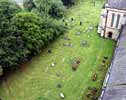Worksop PrioryChurchyard
 The eastern section of The eastern section of
the churchyard |
 The northern section The northern section
of the churchyard |
Worksop may have possessed a graveyard lying to the south of the church as early as the Saxon period, and this piece of land appears to have served for both the priory and town throughout the medieval period, although presumably the burials of the more senior members of the priory were intra-mural, as were many high-ranking secular burials until the early nineteenth century. Holland also suggests that the croft to the north of the church may have been a burial ground, from burials found there and from its post-medieval name ‘Old churchyard Close’. The extent of the churchyard is depicted on Kelk’s map of 1763, stretching between the church and the gatehouse and bounded to the west by the then line of Priorswell Road. Holland describes it in 1826 (p108) as follows:
‘Immediately adjoining the east end of the gatehouse, an iron railing fences the southern boundary of the churchyard, the only ingress to which, is by a pair of light iron gates, which when there are no services, are very commendably kept locked. The burial ground, which although containing 3 roods 30 perches [just under 1 acre] appears to be too small for the parish, is well enclosed, and contains, besides others, a great number of painted headstones; but these being all placed facing the east, and as there is no road on that side of the churchyard, the pleasing effect of their general appearance is quite lost to those who can only pursue the usual path by the western wall.’
The churchyard had been doubled in size by 1885, when the extension is shown on the Ordnance Survey map, to the east of the ruins of the Lady Chapel, accessed off the newly constructed Cemetery Road. The extension was neatly subdivided by wide paths, and there were two linked mortuary chapels, for Anglicans and Nonconformists. Burials ceased in the ‘old’ churchyard to the south of the Priory Church, which was taken charge of by the Borough Council in 1957, and thereafter improved. For the most part, burials ceased in the remainder of the churchyard towards the end of the twentieth century.
The most striking tombstone is located adjacent to the South Door of the Priory Church and commemorates Alice Richardson, who was laid to rest in 1748. Beautifully carved with a skull and crossbones representing death, and flowers to symbolise the frailty of life, it reads:

Hear
Lyeth the Body of Al[i]ce the Wife of
Francis Richardson who
Departed this Life Jany 23; 1748
Aged 37
Behold: this Grave
it doth Embrace,
A Virtuous Wife,
with Rachael’s Comley
face, Sarah’s Obedience,
Lydia’s open hart
Martha’s Care and
Mary’s Better part. |
|